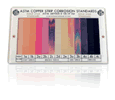We need your consent to use the individual data so that you can see information about your interests, among other things. Click "OK" to give your consent.
ASTM D4048-22
Standard Test Method for Detection of Copper Corrosion from Lubricating Grease
Translate name
STANDARD published on 15.8.2022
The information about the standard:
Designation standards: ASTM D4048-22
Publication date standards: 15.8.2022
SKU: NS-1071825
The number of pages: 5
Approximate weight : 15 g (0.03 lbs)
Country: American technical standard
Category: Technical standards ASTM
The category - similar standards:
Annotation of standard text ASTM D4048-22 :
Keywords:
copper corrosion, copper strip, copper tarnish, lubricating grease,, ICS Number Code 75.100 (Lubricants, industrial oils and related products)
These adjuncts apply to this standard:
Adjunct to D130 Copper Strip Corrosion Standard for Petroleum, D1838 Standard Test Method for Copper Strip Corrosion by Liquefied Petroleum (LP) Gases, and D4048 Standard Test Method for Detection of Copper Corrosion from Lubricating Grease + Active Stan
Selected format:Show all technical information.
Additional information
| Significance and Use | ||||||||||
|
5.1?This test method measures the tendency of lubricating grease to corrode copper under specific static conditions. It may be of some value in predicting possible chemical attack on lubricated parts, such as bearings that contain copper or copper alloys. Such corrosion, for example, can cause premature bearing failures. However, no correlations with actual field service, most of which are under dynamic conditions, have been established. It does not measure either the ability of the lubricant to inhibit copper corrosion caused by factors other than the lubricant itself nor does it measure the stability of the grease in the presence of copper. Note 1:?Because this test method requires the ability to
determine subtle differences in color of copper strips, persons
with certain types of color blindness may find it difficult to
accurately compare a test strip to the Copper Strip Corrosion
Standard.
|
||||||||||
| 1. Scope | ||||||||||
|
1.1?This test method covers the detection of the corrosiveness to copper of lubricating grease. 1.2?The values stated in SI units are to be regarded as standard. The values given in parentheses after SI units are provided for information only and are not considered standard. 1.3?This standard does not purport to address all of the safety concerns, if any, associated with its use. It is the responsibility of the user of this standard to establish appropriate safety, health, and environmental practices and determine the applicability of regulatory limitations prior to use. 1.4?This international standard was developed in accordance with internationally recognized principles on standardization established in the Decision on Principles for the Development of International Standards, Guides and Recommendations issued by the World Trade Organization Technical Barriers to Trade (TBT) Committee. |
||||||||||
| 2. Referenced Documents | ||||||||||
|
We recommend:
Technical standards updating
Do you want to make sure you use only the valid technical standards?
We can offer you a solution which will provide you a monthly overview concerning the updating of standards which you use.
Would you like to know more? Look at this page.





 Cookies
Cookies
